Behavioral strategy to combat choice overload has been saved

Behavioral strategy to combat choice overload A framework for managers
11 December 2015
Behavioral researchers have identified a dizzying array of concepts involved in applying “nudge” tactics to business management. Here’s a straightforward way for managers to make sense of them all.
Introduction
Success, combined with momentum, is a powerful force. In any endeavor, when we see something that works, there is a natural inclination to replicate or even share in that success. In entertainment, box-office success for comic-book movies has spurred the production of a seemingly continual loop of the genre (every week, it seems like a new superhero adventure comes to a theater near you). In professional sports, writers regularly note that in today’s “copycat leagues,” teams and coaches strive to replicate the best practices of the most successful franchises. And business is no different: In industry, many executives are lining up to invoke behavioral economics as the must-use science for a diverse set of issues and objectives.
The framework positions managers to identify and use the behavioral concepts most likely to advance their most important goals.
Behavioral economics combines elements of psychology and economics, with the primary assumption that cognitive biases and/or limitations often prevent people from making optimal decisions, despite their intentions and best efforts.1 Over the last 60 years, researchers and theorists have introduced upward of 80 concepts exploring these predictable biases to which individuals often fall victim, as books such as Nudge; Thinking, Fast and Slow; and Predictably Irrational have helped propel the field into industry’s collective consciousness.2 Behavioral science’s appeal is understandable—it helps explain decisions we make every day—and it’s no surprise why many business leaders have turned to the behavioral field to understand and guide employee and consumer behavior. At every turn, we see compelling examples of how the effective application of concepts translates into powerful outcomes for those that responsibly leverage its insights.
The strength of behavioral economics also lies in its breadth of applications: Examples come from operations, marketing, finance, analytics, government, and many other functions. Unsurprisingly, an increasing number of managers—after having absorbed dozens of silver-bullet strategy manuals and HR guides—are motivated to understand and apply practices that take advantage of a science that can transform human biases into positive business outcomes. However, behavioral economics, boasting immense breadth and a wide range of applications, presents a challenge for managerial application: Despite endless examples of successful applications, few sources offer a managerial framework empowering individuals to first consider business issues within a behavioral paradigm and then to effectively act upon this new method of framing. Entering into this expansive and popular discipline, practitioners may find themselves trying to fit these concepts into their respective businesses rather than positioning their business objectives at the forefront.
This article presents a managerial-focused behavioral science framework that puts the business objective where it belongs: first. We help guide the manager to determine which behavioral dimensions merit consideration, what cognitive behaviors involve promotion or mitigation to achieve the objective, and how to target the specific concepts that, when properly implemented, can increase the probability of accomplishing the stated objective. Executing behavioral-driven policies within an applied framework provides managers with a useful tool-set to achieve their goals rather than relying on serendipitous exposure to a behavioral concept that pairs well with a practitioner’s top-of-mind objective.
In summary, the framework positions managers to identify and use the behavioral concepts most likely to advance their most important goals. We ground our thinking in examples from popular literature, the authors’ own work, and an exercise conducted within the field, placing them as illustrations within the framework to demonstrate productive application of the methodology.
A practitioner’s dilemma—where to start?
It’s often easy to decide to try embedding behavioral insights into your business. It is likely a more difficult task to determine where to begin.
Much management literature is structured to introduce a concept and then provide examples of its existence. In short, the literature tends to be concept-driven. With this approach, aspiring practitioners are confronted with a potentially overwhelming number of concepts to parse through in a quest for insights that will help attain their particular business objectives. The practitioner often must retrofit each example into a relevant, top-of-mind issue. This process tends to leave the reader with a nearly unmanageable number of possible paths to pursue, without much direction on where to start. Practitioners can easily fall victim to one of behavioral economics’ best-known concepts, choice overload, the phenomenon that occurs when too many options are presented; individuals faced with choice overload often experience greater levels of decision fatigue, unhappiness, and choice avoidance.3 Figure 1 provides a snapshot of just some of the numerous behavioral economics concepts that perpetuate the issue of choice overload for an interested practitioner.
A brief history of how we got here
As with many sciences, it is difficult to pinpoint the “birth” of behavioral economics as a field of study. However, we can point to significant milestones along its maturation path. One of the earliest milestones passed in the early 1950s when psychologist Herbert Simon questioned one of the fundamental economic axioms of the rational, calculating human, instead insisting that people make economic decisions with bounded rationality—challenging the idea that human actions are rooted in rationality and mathematics.4 Simon harnessed the teachings of psychology to demonstrate that traditional economic models required a bounded, empirically based rationality theory to guide their insights.5 Rather than centering economic theory on goal-maximizing humans, Simon suggested that the true goal for humans is to “satisfice” particular needs—to achieve minimum requirements or conditions rather than to pursue maximization.6 Following this development, a flurry of behavioral-economic concepts developed over the next 60 years that contributed insights into how humans routinely, consequently, and predictably deviate from rational behavior when making decisions.
Much management literature is structured to introduce a concept and then provide examples of its existence. In short, the literature tends to be concept-driven.
Some of the more notable works that built and legitimized the science include two pieces authored by Daniel Kahneman and Amos Tversky, Judgment Under Uncertainty: Heuristics and Biases7 and Prospect Theory: An Analysis of Decision Making Under Risk.8 The former provides evidence that individuals tend to depend on “rules of thumb” and cognitive short cuts to make decisions (in lieu of always acting rationally); the latter introduces an economic model that confirms that humans frequently mismanage risk at the margins (for high- and low-probability events). Further cementing the relevance of the early works of Simon, Kahneman, and Tversky, this trio represents a very small group of non-economists to be awarded the Nobel Prize for economics for incorporating advances in the field of psychology into economic models.9
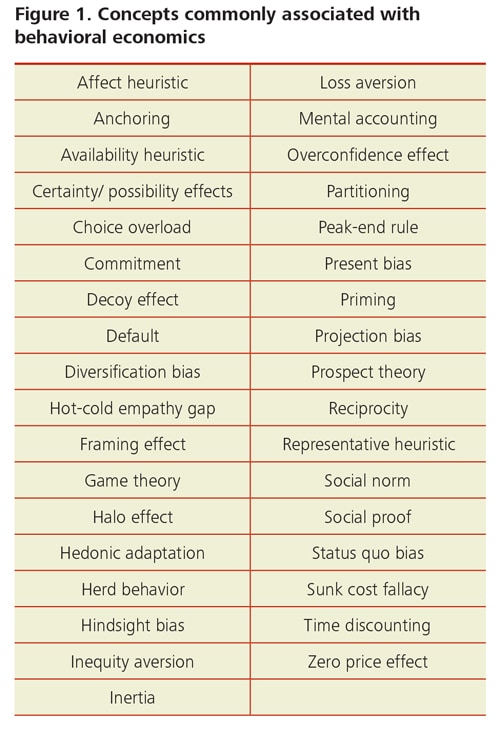
The impact of these early works sparked increased interest, and as a result, researchers developed further insights in pursuit of understanding how humans choose and behave. Its applicability is so prevalent that authors have explored examples of these cognitive biases’ existence in finance, operations, government, and marketing. With an ever-increasing footprint in popular literature, individuals continually seek to uncover and understand bounded rationality more fully while few, if any, look to present a thought process to assist business practitioners to effectively implement these insights. Instead, insights into cognitive biases spurred more concepts that matured the literature, and over a period of time, gave us a foundation of information and corresponding examples contributing to the explanation of why humans are “predictably irrational” (as shown in figure 1). But while contributions to the field have continued to gain momentum, researchers may have missed an opportunity to apply a proportionate amount of attention toward methodologies to appropriately manage and direct these concepts in a managerial environment.
Putting the objective in focus
A foundational concept in the behavioral field is choice architecture, explaining how the way choices are organized influences behavior.10 As mentioned earlier, over time the behavioral sciences field has fallen victim to one of its own insights, choice overload. A better choice architecture may be necessary to assist managers in leveraging insights from the field. In developing a managerial framework, our aim is to offer a choice architecture that guides managers in applying behavioral insights in their own environment.
Organizing the choice dimensions
If the behavioral field suffers from choice overload, how can we establish a better architecture to guide managers? The most straightforward path is likely to reduce choice. We posit that behavioral concepts can be organized into the following five choice dimensions:
Outcomes valuations—Will individuals have to value consequences? This dimension captures a major aspect of the field related to the valuation of gains and losses. Much of the literature suggests that a major cognitive bias is rooted in humans often being more sensitive to losses than they are to gains (the underpinnings of the prospect theory).11 A core assumption in rational economics suggests that when faced with a decision amongst a set of alternatives, an individual will choose the one with the greatest expected value, and do so consistently.12 However, for a variety of reasons, listed in figure 2, biases can often cause individuals to overemphasize potential losses, maintain the status quo, and consider alternatives relatively rather than absolutely. Indeed, individuals rarely act as rational agents when making trade-off decisions due to biases incurred when evaluating potential outcomes.
Calculation bias—Are individuals required to process uncertainty? These concepts consist of the multiple ways people process information, often under time constraints. These methods of mental processing are referred to as heuristics, a term that captures simple “rules of thumb,” or mental short cuts, upon which individuals rely to make judgments. The underlying concepts demonstrate a class of short cuts that individuals routinely take that lead to systematic errors in judgments. These heuristics often lead to failures in statistical thinking.13
Timing elements—Will decisions made in the present alter future outcomes? This dimension captures the variety of insights pertaining to the role of timing on decision making processes.14Most commonly, they highlight human biases toward present outcomes and how we are poor predictors of future sentiment and behavior.
Environmental influences—Is there an opportunity for external factors to impact behavior? Often our environments affect decision-making, frequently in manners that lead to irrational behavior. The concepts associated with this dimension provide evidence of how both our physical and social environments perpetuate our cognitive biases.
Choice architecture—Can we influence behavior by how we organize choice? The choice architecture dimension captures the variety of concepts that demonstrate our ability to influence decisions with the layout of alternatives.15 An everyday example of choice architecture is the restaurant menu.
Our purpose in defining these five dimensions is to significantly condense the complex and varied behavioral field into a more manageable superset that helps direct managers in implementation. The corresponding questions provide a dual purpose: They direct many of the concepts associated with the behavioral field into one of the five dimensions (figure 2 provides an organized summary for a selection of the most popular concepts) and guide users toward the avenues of the field most relevant to a specific objective.
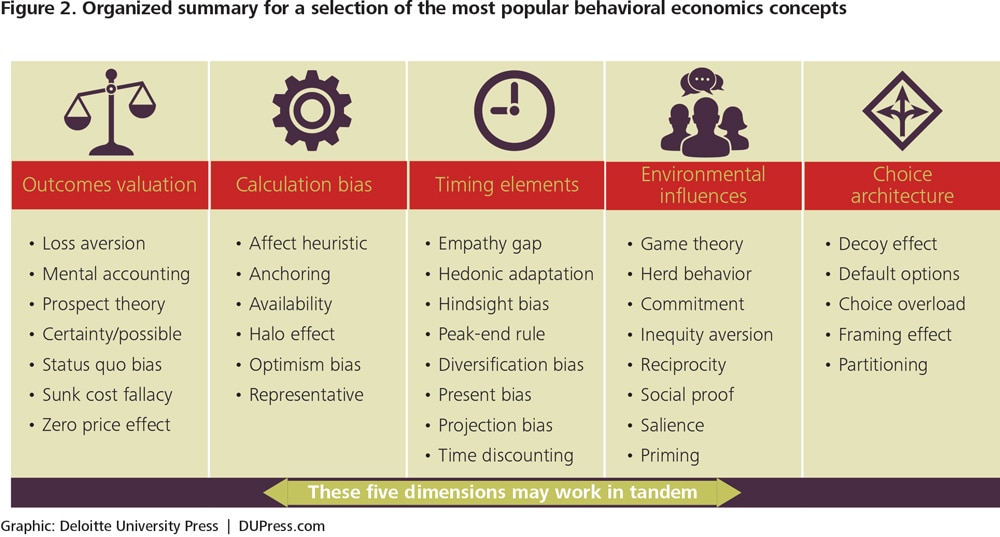
Repositioning information in this manner can carry the same demonstrated benefits as a well-constructed database architecture. Instead of scattering information in a random order across a series of data sets, the information is organized into applicable groupings for the user (similar to a marketing database with a well-maintained and intuitive data architecture for customer attributes, financial data, and demographic information). And like a database, a key feature of the information construct is acknowledging that the five dimensions may work in tandem. That is, a single business objective may encompass multiple dimensions of the behavioral field (we do not assume each concept works in a vacuum)—or, in the case of a marketing database, if building an insightful dashboard, one might want to not only understand who the customer is but also what the purchasing behavior is, over a variety of dimensions such as timing, sales channel, and location.
Transitioning the outlook of the field from figure 1 to figure 2 provides a visual cue to the power of choice architecture. By reducing the choices, managers may be more easily directed toward the relevant areas of the field to further their objectives.
Where the objective and human choice intertwine
Thus far an approach has been presented to organize the behavioral field’s vast assortment of insights into a simple and, hopefully, useful taxonomy. We now turn our attention to positioning choice dimensions relative to a leader’s business objective. Figure 3 structures the managerial framework into four levels. The practitioner must consider every level, each of which encompasses the one below it—beginning with the most important, the business objective.
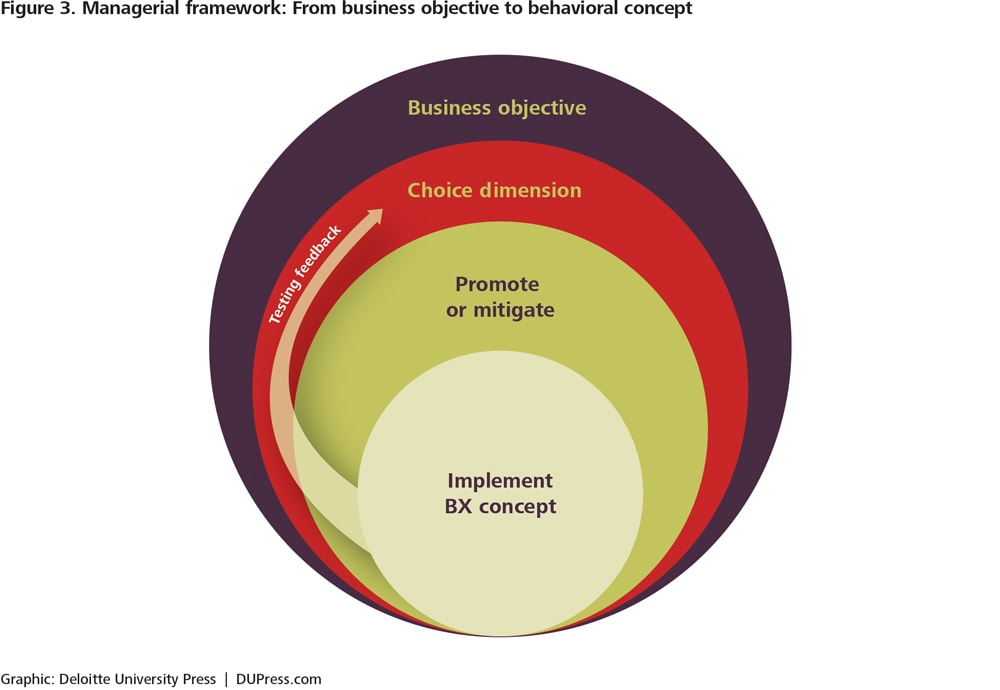
The following breaks down each level of the framework:
1. Business objective—The framework’s most important feature, identifying the objective. Before exploring the behavioral aspects, it is important to understand the business objective, from which everything else must be grounded. Table 1 provides five common areas that embed (or have a high potential to embed) behavioral interventions into one’s objectives.
2. Choice dimension—After identifying the problem and laying out an actionable objective, one can determine the relevant choice dimension(s) that may influence the likelihood of success. For each of the five dimensions identified in figure 2, the related questions help guide the manager to the correct group of concepts to help further the objective.
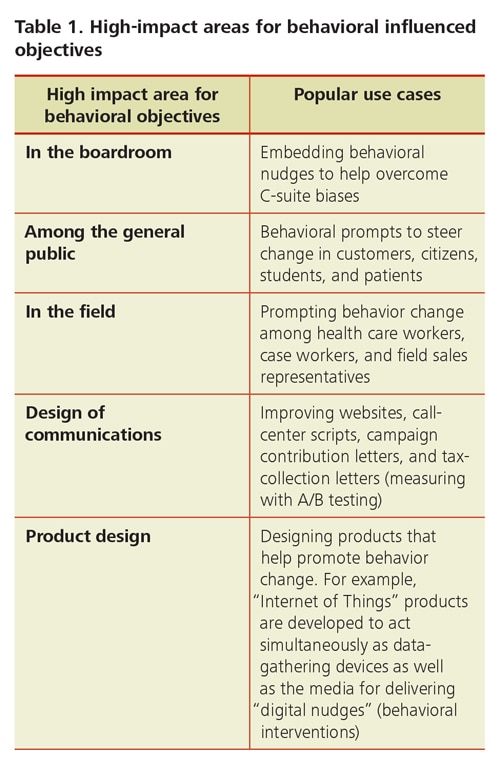
It is important for a manager to evaluate and prioritize which of the choice dimensions most appropriately support the objective. Absent a critical mindset, one may easily fall into the trap of looking to fit every dimension into any objective—“when all you have is a hammer, the world is a nail.”16
One method to condense the choice dimensions is to consider how much influence as the practitioner you have on the dimension. For example, individuals working within a call center may have very little control over their ability to offer and evaluate alternative outcomes to their customers. However, the employees can use many of the dimensions from the choice architecture during their conversation to nudge toward a desired result. Determining the scope of influence an employee has is an important determinant of which choice dimension to pursue. To help increase the likelihood of success, begin by evaluating the context and pursue the dimension that is most enduring and relevant to the business objective.
3. Promote or mitigate—Once the relevant choice dimensions are determined, one should decide if these are behaviors that should be encouraged (promote) or reduced (mitigate). This is the point in the framework at which it is likely necessary to review the relevant concepts associated with each dimension. For example, to create an effective framework, we want to mitigate choice overload for the manager (see the sidebar, “A note on ethics,” for a discussion on the proper usage of promoting or mitigating behavior).
4. Implementing the behavioral concept—When the concepts are narrowed to a relevant subset and a decision is made to encourage or mitigate the behavior, it’s crucial to develop specific implementation tactics rooted in the concept that will most appropriately support the stated objective. As with any new implementation, it is important to test and revise (if necessary) the pursued solution. If revisions are required, consider initiating iterations at the choice dimension level.
Framing behavioral insights through a manager’s lens offers an alternative perspective to navigate the field. The default no longer has to be to start with the concept and retrofit the findings to a relevant issue. Now the journey begins with the business objective and aligns the most appropriate concepts in support of the goal. That critical shift may empower the manager to drive the concept rather than the reverse.
A note on ethics
When engaging in techniques to promote or mitigate a particular behavior, it’s important to consider the ethical ramifications of our actions. Many interventions occur without an individual’s awareness of the psychological tactics applied.17 In many cases, people invite the opportunity for behavioral interventions that aim to improve their wellbeing (increasing savings, improving health, or quitting smoking). Other times, people demonstrate an indifference to behavioral nudges (setting defaults or arrangement of menu options).
When behavioral interventions are applied against one’s discretion, there may be debate concerning ethical appropriateness: Are we undermining people’s free choice, or are we simply steering people toward a particular path?18 This question may merit consideration for a subset of potential interventions.
Applying the framework
The merit of a managerial framework derives from its productive application in the field. The ensuing section contains three examples that highlight the practical value of the methodology. We explore one case from each of the following: popular literature, our own work, and experience in applying the framework with the field. The literary example will demonstrate that reframing an issue by leading with the objective (rather than the concept) can result in the efficient execution of the behavioral insights. The second example highlights the framework’s flexibility when applied to a broad objective encompassing multiple choice dimensions. We end by recounting an exercise that was conducted with a project team within the field to highlight the framework’s applicability to new, unresolved cases. A visual representation of the applied framework will accompany each example to reinforce both the framework and the flexibility for the practitioner to transition the learnings to her own objective.
The power of free
In Predictably Irrational, Dan Ariely introduces the zero-price-effect concept.19 In summary, people systematically overvalue an item advertised as “free” relative to that item’s true value. To illustrate the existence of this phenomenon, he provides a real-world example, in which Amazon.com transitioned from a low-cost, 1 franc (approximately 20 cents) shipping fee in France to promoting “free shipping” for orders over a certain amount. As the zero-price effect suggests, consumers disproportionately valued “free shipping,” and Amazon’s sales substantially increased. Regardless of the total price decrease netting only a 1-franc savings, consumers found the free-shipping offer significantly more attractive.20
Let’s take this powerful illustration of the zero-price-effect concept and pivot it to begin with the business objective and build toward the implementation of the behavioral concept. Reframing the issue demonstrates that we can effectively implement the concept when placing the objective at the forefront. In other words, we properly recognize that the objective is to increase revenue and not, as the framing of the original example suggests, to deploy zero-price effects into a company’s workflow.
By enhancing the focus of the behavioral field to center on the objective, we create a smaller, more relevant universe of concepts to explore.
Navigating through figure 4, we see how each level of the framework directs a manager from the business objective to the implementation of the concept. Leading with the objective, we can infer that a company’s initial objective is centered on increasing the average order size (as referenced in table 1, this objective relates to influencing “the general public” area).
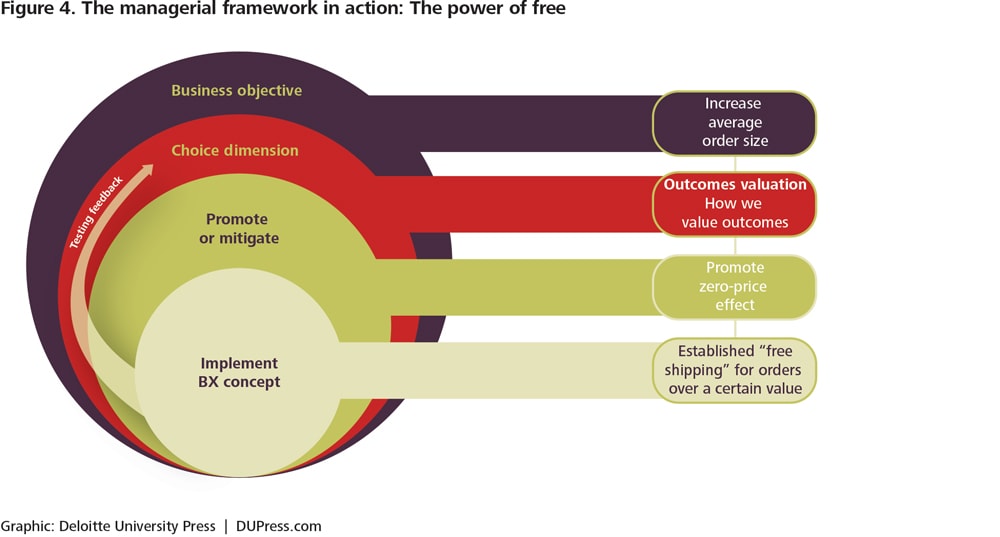
The next level considers a suitable choice dimension to support increases in average order size. As with many purchasing decisions, consumers should actively balance the perceived gains (products) with the anticipated losses (income). This suggests that understanding outcome valuations is a relevant choice dimension in influencing the average-order-size objective.
By enhancing the focus of the behavioral field to center on the objective, we create a smaller, more relevant universe of concepts to explore. In a managerial context, since the science is limited to the most relevant insights in support of the objective, the investigation of concepts becomes a considerably more efficient endeavor. One of those potentially relevant behavioral insights is the zero-price effect. As noted from Ariely’s explanation of the “power of free,” consumers systematically overvalue the idea of “free.”
This scenario illustrates how we do not always want to mitigate people’s inherent biases. Promoting the zero-price effect capitalizes on the human instinct to overvalue “free.” Tying back to the objective, encouraging this bias makes it a strong candidate to effectively increase average order size. The last level of the framework—implement the behavioral concept—represents the opportunity for which the manager needs to bridge the concept with the business practice. In this case, Amazon established an order-size threshold that it deemed cost-effective in balancing the anticipated increased consumer demand. It is important for the practitioner to test and measure the effectiveness of the implemented behavioral treatment (as Amazon did in comparison to the 1 franc offer).
This example retains all of the original study’s elements. The distinguishing difference between the two methods of framing is that the practitioner takes behavioral findings into account.
Curbing workplace interruptions
The article Stop or not? How behavioral factors affect decisions related to work interruptions takes a broader view of behavioral influences on workplace productivity.21 Through a series of studies, the authors highlight several behavioral insights that explain how interruption typically affects workplace productivity. The following represent three of the major takeaways to enhance productivity:
- When near task completion, workers are more motivated to focus and complete their responsibilities. This suggests that managers, to enhance overall project focus, should assign a series of short tasks, because people are less likely to allow themselves to be interrupted and will therefore be more productive.22
- Managers’ unannounced monitoring generates greater interruption than the intended “motivational” consequences. Social dynamics play a role in perceived intimidation and often result in employees inefficiently switching projects and prioritizing work.23
- Creating incentives for higher-priority projects effectively minimizes work interruptions and transitions to lower-priority tasks. Organizations can take advantage of how individuals perceive outcomes to align incentives in a manner that keeps workers on task and dissuades interruptions.
Managers can easily analyze these takeaways within the framework to highlight its usefulness in applying these concepts to a broader objective such as reducing workplace interruptions to increase productivity. This demonstrates another instance where behavioral interventions are implemented to advance worker productivity “in the field” (refer to table 1). Figure 5 highlights how a variety of behavioral factors can work in tandem to support an overarching objective.
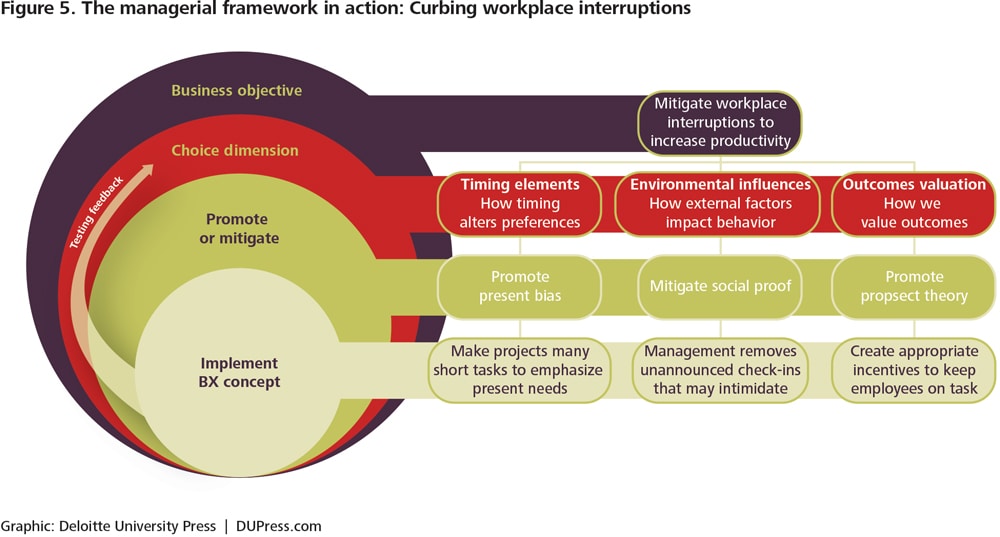
As figure 5 demonstrates, the framework represents each of the article’s three takeaways, which cascade accordingly from three of the five choice dimensions. For example, as with any project work, there are timing elements. When considering timing, a prevalent behavioral concept is the present bias. Humans naturally place more emphasis on payoffs occurring closer to the present than those taking place further in the future.24 When structuring workload and tasks, the manager may positively promote this bias by breaking down the project into a series of short tasks that play off of our inherent preference for experiencing near-term payoffs.
Additionally, we are able to recognize environmental influences on task completion and how managers often enforce social influences in an attempt to create results. Behavioral science research has shown that unannounced social pressure from management often leads to work disruptions requiring organization-wide amelioration.
The final dimension, outcomes valuation, acknowledges that employees are mindful of the perceived value proposition for taking any number of actions (this is at the core of why we seek employment). To capitalize on this behavior, organizations may leverage prospect theory to establish an incentive program that properly motivates workers to engage in efficient, minimally interrupted task completion.
Both examples explored thus far retrofit the framework to the conclusions already presented through a different lens. To demonstrate its application for managers seeking to support a future objective with behavioral concepts, the final example recounts an exercise conducted within the field to demonstrate how a business leader can leverage the framework to guide implementation on new and unresolved problem sets.
Influencing pricing strategy
Through predictive modeling, pricing teams can segment customers and recommend an optimized pricing package (based on a variety of factors) to potential customers. However, in environments where human judgment can influence the final package offered, bounded rationality may tempt one to disregard the optimized recommendation in favor of an alternative; this is sometimes referred to as a “last-mile problem” (see the sidebar below for more detail).25 In a live field exercise, our managerial framework was applied to influence greater staff adherence to analytically based pricing strategies with the added assistance of behavioral nudges. With the framework as our guide, we analyzed the scenario as follows (see figure 6 for a summary of recommendations):
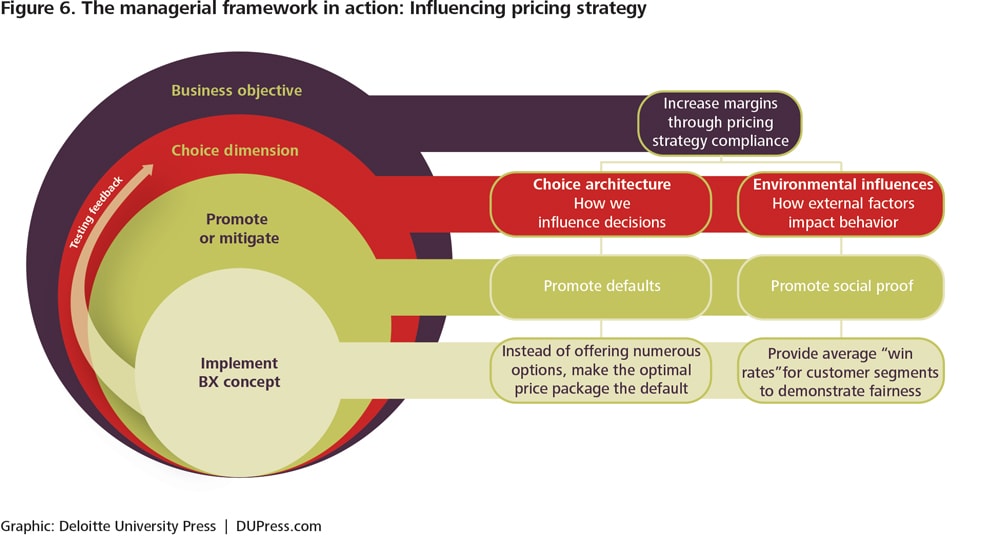
Business objective—The primary objective was to increase staff adherence to data-driven pricing strategies.
Choice dimension—Using the choice dimension questions as a guide, we can highlight which set of cognitive biases most pertain to increasing pricing compliance by internal service teams.
Through these efforts, the team can assess a subset of actionable behavioral insights that align with the business issue at hand.
Is there an opportunity for external factors to affect behaviors? Through staff interviews, a common theme emerged—Individuals questioned if analytically based pricing strategies were competitively set for specific customer demographics for which staff perceived pricing to be relatively inelastic. The environmental dimension influenced those expected to comply with the analytically based strategy.
Can we influence behavior by how we organize choice? The various pricing packages offered were organized by the pricing team. Therefore, an opportunity to influence decisions through choice architecture existed.
The other choice dimensions were considered but determined to be less immediately applicable (or controllable). For example, Will decisions made in the present influence future outcomes? The moments addressed in this scenario were isolated to point-of-sale moments. In other words, a substantial opportunity to influence future cases in this environment did not immediately come to mind. However, if the tested recommendations do not yield positive results, this is the layer of the framework to reassess that claim.
Promote or mitigate—In order to address staff concerns regarding competitive pricing packages, the social proof concept could merit promotion. Individuals often feel more confident in a decision if validated by the behavior of others. In determining final implementation strategies, this presents an opportunity to underscore the success of others.
When assessing the current choice architecture, a large number of pricing packages were currently available. It was hypothesized that this made it increasingly difficult for staff to determine the leading package to present to the prospective customer. This afforded the team an opportunity to promote a default option that encompassed the analytically supported pricing package.
Implement the behavioral concept—To implement the promotion of social proof, the pricing team may consider highlighting past “wins” for the price offered to each customer demographic. This would demonstrate to the staff that peer groups have found this offering acceptable in past instances. It also provides the staff with the knowledge that others have achieved effectiveness with these recommended pricing packages.
The choice architecture was reassessed with greater consideration to organizing pricing sheets with the analytically driven option set as the default. This gentle nudge may naturally influence people to pick the more optimal package and, therefore, increase strategy compliance without significant effort.
The last-mile problem: How data science and Behavioral science can work together
In applications ranging from hiring employees to underwriting insurance contracts to triaging patients, “playing Moneyball”—using data analytics and predictive models to make decisions—reliably outperforms unaided judgment. But predictive models face what might be called a “last-mile problem”: They yield benefits only if appropriately acted upon. Often, this is (in principle) a straightforward economic decision: If a model indicates that Aparna will code better than Ben, you might hire her first; if Carly is predicted to be a riskier driver than Dev, you might set her premium accordingly.
(In practice, it is not uncommon to face “last-mile” problems such as overcoming organizational resistance or evaluating how to weigh case-specific information with predictive model indications. While important, these are separate discussions.)
But in many situations, the “augmented intelligence” offered by predictive models isn’t enough: Augmented behavior is needed as well. Suppose a fraud model suggests that Greta has higher than average odds of embellishing her insurance claim. Though valuable, such indications by themselves don’t necessarily warrant decisive action, and it is expensive to investigate everyone. It turns out that certain behavioral economics applications can prompt some cases to “self-cure”: Targeted behavioral nudges (such as pop-up screens on a website) can be designed and optimized to invoke people’s intrinsic desire to be good citizens. To take another example, suppose a predictive model indicates that Hal is likely to fall behind on his child support payments. Low-cost nudges such as invoking social proof and using commitment devices might lessen Hal’s risk of falling behind. Such ideas should not be taken on faith. Whenever practical, such nudge tactics should be field tested using randomized controlled trials to estimate their potential economic benefits.
Data science and behavioral science can be viewed as two parts of a greater whole. Behavioral science gives us a powerful new set of tools for acting on data analytic indications when behavior change is the order of the day. And data science can help overcome “the flaw of averages” by moving from population-wide to personalized behavioral interventions. For a specific person, there might be a specific intervention with his or her name on it.
See the Deloitte Review article “The last-mile problem” for more information.26
Bringing the framework home
Behavioral insights merit the growing attention paid to the subject matter. Continual examples appear in popular literature, academic circles, and industry of how our cognitive biases consistently prevent rational behavior—and how those demonstrating an understanding of these biases systematically outperform their counterparts.27 However, even when we recognize the power of understanding these biases, the literature is so fragmented that it is an entirely different endeavor to determine how to integrate these insights into relevant workflows. For new practitioners, especially in business, the science often suffers from one of its own issues: choice overload.

To help combat choice overload, we offer a choice architecture that enables business leaders to apply learnings from the behavioral field in an accessible manner through the five choice dimensions. We then position this information in a four-level framework that acknowledges the importance of starting with the business objective and directing the behavioral concepts in support of organizational priorities.
Taking the framework home
Finding your objective. As stressed throughout, before we can assess the science, it’s important to understand the objective. Managers should take time to establish their most pressing objectives. From this set, narrow the focus to those objectives requiring a high level of human decision-making and uncertainty processing. Table 1 provides five areas where behavioral influences have been identified as effective tools to help advance business objectives.
Mapping out the framework. Go through the exercise of filling out the framework similar to figures 4, 5, and 6. Structuring the choice dimensions facing each objective can help immediately remove much of the ambiguity associated with the process.
Experimenting and revising. When implementing a series of concepts, embrace the learnings. Engage in a testing process to observe if the implementation strategy is effective—and if not, remap the framework and revise the experiment.
The demonstrated advantage of this framework lies in its flexibility. It provides direction but does not direct. Business leaders still drive the objective; the framework exists to further those goals with the added assistance of behavioral insights.
© 2021. See Terms of Use for more information.




